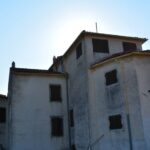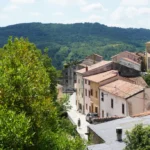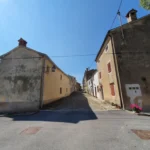Located on a 256-meter high hill in northern Istria, Višnjan seems small at first glance but is filled with a medieval historical heritage that will amaze you.
Višnjan which has become more popular in the science districts rather than in the touristic sense is the place that will show you the full ambience of central Istria. And I would like to underline that fact since it is a crucial thing that enabled that place has succeeded in retaining its original form, under the blue or starry sky. It’s with no doubt the place you should go if you are looking to find Istrian architecture’s uniqueness kept the past traces.
Although not so common a topic of famous tourist magazines, such as some of its neighbours such as Motovun, Oprtalj or Grožnjan, Višnjan seems to be one of the few Istrian places where we will get to know the feeling of Istria as it once was. It is certainly one of those small towns that have managed to retain its authenticity in its original form. And certainly, only ten kilometres away from the sea, this place of unforgettable views of the Umag-Poreč archipelago, is one of those that we will not easily forget.
Things to do in Višnjan
When I first visited Visnjan, I quickly realized that is a town of stunning traditional architecture and beautiful views. It provides a choice for travellers looking for inspiration and respite. Walking the cobbled streets we will notice that every stone and every corner of this city speaks of its past. This past overlooks the most part by the Venetian legacy. Morever, Venice rule took the long period, with its peak in the 15th and 16th centuries. During the war in 1617, the place was devastated but later received a new direction of development. Since it seems to be called the city of cherries translated from local language, the origin of the name, in reality, has nothing to do with the fruits of cherries (at least as far as I know). The town with ancient names of Vissignanun, Vicinus or Guissignanus developed however much earlier as mentioned in written history.
The first settlement grew on the foundations of the prehistoric times of Illyrian and Celts. Remains of the walls, pottery and bronze found on Mount Montenes, as well as copper earrings (similar to ” Buzet Earrings “) testify that life on a prehistoric hillfort began between 2000 and 1000 BC. Its name suggests that was located “in the immediate vicinity” or ” next to” Parentium, once the capital of the western coast of Istria. Since that time, through the Middle Ages, Višnjan has developed and engraved in the time. So let’s see in this article what Višnjan offers today.
Enter the city Gate
Ascending to the old part of Visnjan, the first thing we see is the Great Gate or the Old Gate ( Porta Grande or Porta Vecchia ). They are a typical remnant of the symbols of the Venetian legacy from 1750, decorated with a Venetian lion. They were located next to the houses of the Dal Oste and Maladossich-Declich families. Furthermore, the ascent of a paved street with colourful architecture will lead us to another gate – the Little Gate ( PortaPiccola ) which dates from the 16th century. In the time of the Serenissima, the city was entered through a lion sign with an open book, meaning that it was built in peace. The second gate reminds us of some forts in Istria with several city gates, such as Dvigrad.
Enjoy the stunning views from the city loggia
Just when I took the photos of the Venetian loggia, I realized that this is one of the most beautiful loggias in Istria. The loggia is not only a favourite place where generations of young people have gathered for centuries but also a place of great and unforgettable views that stretch to the coast of Umag in the north and Vrsar in the south. Any time is good to visit, and perhaps best during sunset, which will reveal the most beautiful charms of the archipelago.
During the Middle Age, the wall next to the loggia served as a purpose for the peasants to lean their hoes on so that the landowners could see who was working harder and thus hire farmers. However, as the peasants began to exchange tools in solidarity and falsify their balances of work on the land, it is believed that such a custom failed.
Stroll Višnjan main square
Decorated with the architecture of the Sinčić Palace and several houses, this square is rich in historical heritage. The cistern located right in the middle of the square reveals true authenticity. The square is dominated by a beautiful facade bell tower from 1772. It should be photographed because from its 27 meters this symbol of the city will remind us of a visit to Višnjan.
Parish St. Quiricus and Julita from 1833 was built on the site of an earlier church from the 13th century. Its interior is adorned with valuable paintings such as the Three Saints, painted by Palm Junior, in the late 16t century and Mary of 1598. The latter is the work of Zorza Ventura, the master of Zadar.
Admire the Gothic chapel of St. Anthony the Abbot (Sv. Anton)
Walking down the cobbled street at the foot, we will find a 15th-century Gothic church. Impressively decorated carved stone blocks, a slate roof and a bell tower on the façade are its basic features. The interior is decorated with frescoes.
Walk Antun Korlević Park planetary sculptures
One of the Višnjan science symbols is AntunKorlević park. The scientist (1851-1915) was the first Croatian higher education teacher of entomology at the Forestry Academy in Zagreb. This park with seating benches and parts of the shade is like a small-town museum. What catches the eye the most is the sundial. Astronomical sculpture, in honour of the observatory, is a place recognizable in astronomy.
Observe the stars from the Tićan Observatory
One of the main things making Višnjan world recognizable, particularly in the last few decades, is the observatory, located in a little village of Tićan, next to the town. The town’s observatory location was due to lower light pollution moved to the hill next to it. According to the source of the Višnjan Tourist Board, the installation of non-ecological lighting and the increase in light pollution in Istria between 2000 and 2001, the level of brightness of the night sky is growing to a critical level. The same complicates the previous scientific work.
However, such of thing didn’t disrupt the team that the observatory telescope would discover more celestial bodies than a majority of other observatories in the world. And the something that will sound more incredible is that Višnjan Observatory ranked 5th in the world by the number of small planets it discovered in 1999. Today is in the community to be one of the best 3 observatories in the world. Prof. KoradoKorlević found the observatory. He is also the head of the Višnjan Scholl of Astronomy, a Croatian teacher and prolific amateur astronomer. It is the 11th most productive asteroid tracker. Two comets bear a name after the recognizable Istrian scientist. If you are a scientist enthusiast like me, you should visit Tićan Hill which is 3 kilometres half away from Višnjan.
Learn about Boškarin ox
Višnjan is the seat of the Istrian ox association known as Boškarin. The association was founded to protect this animal, which almost became extinct at the end of the last century. The huge grey ox with large horns, which often weighs more than a ton next to the goat, is a recognizable animal of Istria that meant life. Boškarin was used for cultivating the land, he pulled the plough, tools for ploughing, but also transport. Apart from Višnjan, another recognizable place for the Istrian ox is Kanfanar.
Find out more about Višnjan by peeking into the Mandalenjina feast
For those who love traditional festivals, a visit to Mandalenjina, a folk festival, is an ideal choice to learn more about the traditions of this part of Istria. The festival, which takes place at the end of July, in honour of St. Mandalene, the patron saint of the city, offers many opportunities: sports competitions, cultural and artistic programs, dance music and the cultural and economic life of Istria.
Bonus thing to do: visit Astrofest in Tićan
There is no doubt that the surrounding landscapes provide an excellent opportunity to taste some of the fruits and vegetables, including cherries, but what makes Visnjan special is the science of the stars. The festival in honour of the summer solstice attracts and unites fans of astronomy, mystical history and ethnic modern musical rhythms. During the shortest night of the year, June 21-22, according to myths and legends, the real and surreal worlds collide. Then fairies and elves visit the Earth, bringing with them a touch of the mystical and magical. Astrofest is then held in Tićan.
As the summer solstice is associated with several legends about customs, during the shortest night of the year, festival visitors celebrate a return to the past. It is necessary to stay awake from the farewell of the Sun, waiting for it to rise again. With the same we follow the path of the ancient civilizations of the northern hemisphere, which celebrated the Sun, considering it a symbol of life.
Daily tours from Višnjan
Located in the northwest of Istria, the Višnjan area is picturesque. Besides being bound by the hilltops and the green Istrian hills, the site is recognized as a combination of the sun and the sea. While driving alongside Višnjan surroundings, I could see a red land, where the grape and the olive fruits poured into wine.
The olive oil became nectar for the healthy for the sick and the poor, the people and the Gods. So wherever you decide to go, just start searching, since you won’t be wrong! Here we prepared only a few of the ideas about the Višnjan surroundings.
Nova Vas and Baredine Cave
Nova Vas’s place in Istria’s interior is 6 km away from the tourist destination of Poreč. It is just 10 minutes of drive from Višnjan. A parish church of St. Roco dating back to 1853 dominates over the tiny place. It was built on the site of an older one dedicated to St. Anthony the Abbot first built during the 16th century. Since Istria’s interior is ideal for an active holiday, Nova Vas is an excellent place for a quiet holiday away from the hustle and bustle. The recommended activities one would enjoy are mountain biking or speleology. Popular Baredine Caves makes the place most recognized. The four rooms are abundant in stalagmites, stalactites and interesting sculptures shaped by the water for thousands of years.
Motovun
One of the most popular, and for some, the most magnificent medieval Istrian hilltop is located in the central part of the peninsula overlooking Mirna and Motovun Forest’s valley. You should visit this picturesque town from which the town walls built during the Venetian rule extend the fantastic view no matter the direction you look. Besides it has become known as Motovun Film Festival taking place in the summer, Motovun is dominated by the bell tower considered the highest point over the Mirna Valley.
Žbandaj and Bačva landscapes
Located in the vicinity of VišnjanBačva is a tiny place with the rural architecture of Istria. Besides having a fantastic view extending of Poreč archipelago, Bačva is surrounded by breathtaking landscapes. Those are filled with olive groves and vineyards. Continuing to drive from the south direction, you’ll soon reach the other small place Žbandaj. The site first mentioned in 1570 but inhabited in the Illyrian times. A three-nave parish church of St. John and Paul the Martyr dominate over the entire place. You should take a photo of the 20 meters high bell tower. Don’t miss stopping by the church built in 1595 on an older one. The church’s interior is decorated by several works of art with rustic characteristics and a sprinkler carved in 1688,
Zamask
The place offers magnificent views extending all sides that are considered almost one of the best, while looking from Učka Mountain direction to the Adriatic Sea. It lies on a 411 m high hill. Zamask may be tiny. However, the parish church of St Michael dating back to 1177 makes him historical. And the belfry next to it offers a uniqueness.
Besides enjoying the incredible view and the green landscapes that bound the place, you shouldn’t miss stopping by the smaller church of St. Martin. Once you should know this village from 1535 to 1797 made the state border between the Venetian Republic and the Austrian Empire. The Venetians called their part of the village Zumesco (Zumesk), and the Austrians Zamasco (Zamask).
Karojba
This unique village is filled with four 15-metre high pine trees with umbrella-like treetops. Some of them are 200 years old. While you come to the town, don’t miss look a parish Church of All Saints (CrkvaSvihSvetih), dating back to 1580. A 22-metre high bell tower is nexto it. The church located in the cemetery dating back to the 13th century. It contains carved remains dating back to the 8th century.
Višnjan Outdoor
Step out of Višnjan’s old town, and you’ll find yourself embraced by green glades, winding trails, and quiet paths that invite you to slow down. Here, nature isn’t just scenery—it’s an invitation to wander, breathe, and explore at your own pace.
Jump on Two Wheels. Take a bike and let Višnjan reveal itself. Pedal past ancient monuments, through olive groves, along hilltops and hidden valleys. Every turn of the path offers a little discovery: Roman roads whispering history, the silent remains of rustic villas, and the gentle rhythm of the Istrian countryside. Trails are marked, but the real joy is in letting curiosity guide you. There’s no need to rush; the journey itself is the destination.
Walk 365. For those who prefer their own two feet, hiking around Višnjan turns every step into a story. Follow the path to the “Venetian Lion,” a quiet witness to the Venetian Republic’s medieval rule. As you walk, the landscape slowly unfolds—meadows, forests, and small glades revealing themselves like secret chapters of a book. Here, time seems to stretch, letting you truly savor each moment.
Višnjan is a place to wander, to pause, and to return to a slower rhythm, where every trail and every hilltop has a story waiting for you.
Putokoza local tips of Višnjan
Višnjan is undoubtedly a place where you might meet space travelers, savor homemade fuži, or simply lose yourself in the view. If you’re seeking warm, welcoming people who make you feel at home, Višnjan won’t disappoint. It’s a perfect choice for a day trip—or even a longer holiday immersed in the heart of Istria.
- Eat: Have brunch at “Borgonja.” This one of the last oases of autochthonous Istrian cuisine is located on the main street of Višnjan. Let them suggest what was freshly prepared that day in the kitchen.
- Taste: donkey’s milk: One of the indigenous Istrian products, produced at a station near Višnjan, is valued for its strong support for immunity. It is especially good for bronchitis treatment and is not far from Višnjan.
- Learn: a lot from Korado Korlević at the observatory lectures, a place where the stars fall most beautifully. Višnjan is undoubtedly a place where you might meet space travelers, enjoy homemade “Fuži,” or appreciate the view. If you are looking for a place with caring people who will win you over, don’t hesitate to visit Višnjan. It is a great choice for a day trip or as a holiday destination.
Getting to Višnjan
✈️ Air: Several airports are within reach. Pula Airport is about 60 km away and serves as the main gateway to Istria, being Croatia’s fourth busiest airport. Rijeka Airport is approximately 120 km away, around a 1 hour and 40 minutes drive. Trieste Airport, in Italy near Monfalcone, is about 110 km away. Venice Marco Polo Airport is roughly 220 km from Višnjan, and Zagreb Airport is around 270 km (or 290 km via Slovenia).
🚌 Bus: Public buses connect many parts of Croatia and the Istrian coast. However, lines through central Istria are infrequent. Occasionally, local buses run toward Višnjan.
🚆 Train: The nearest train stations are in Buzet or Koper. From there, a private transfer or taxi is necessary, as Višnjan is about 31 km from Buzet and 50 km from Koper.
🚗 Car & Parking: Višnjan has become increasingly popular, and parking is available at several locations near the town’s foothill entrances. Recommended spots include A. Korlević Park or parking just outside the town.



